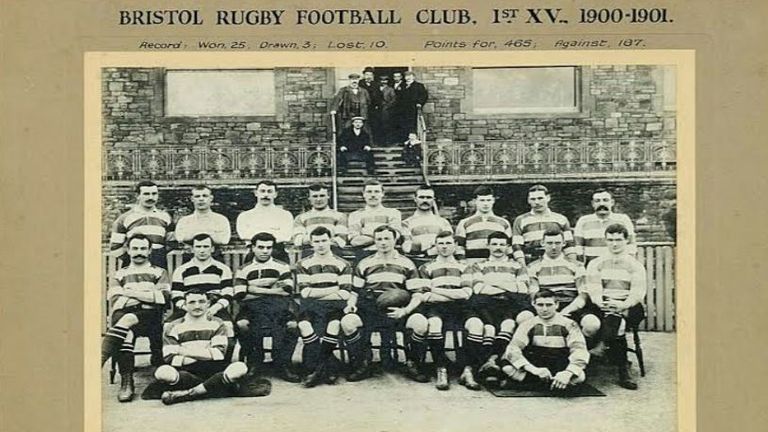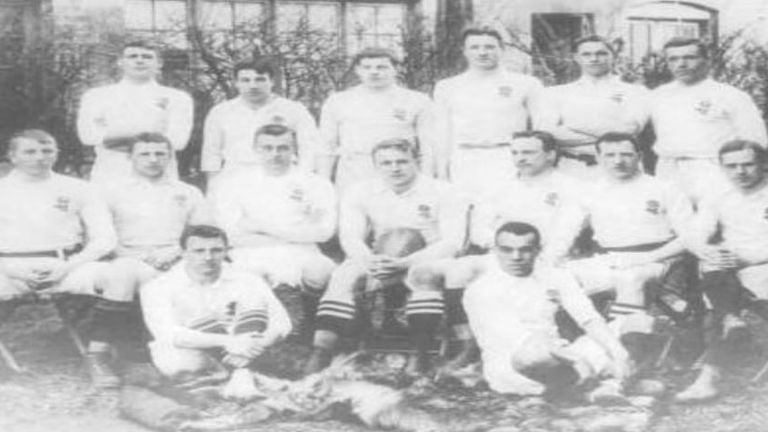James 'Jimmy' Peters: The tragic and turbulent story of England's first black rugby player
The story of England's first black rugby player James Peters, who experienced family death and exile from a young age, moved from a circus to an orphanage and then, into adulthood, represented England in 1906; Discrimination at many turns saw him play out his later career in rugby league

Tuesday 25 October 2022 10:03, UK
This Black History Month 2022, we look into the tragic and turbulent story of James 'Jimmy' Peters, England's first black rugby player.
In fact, not only was Peters the very first black man to represent England at rugby in 1906, he quite remarkably, remained the only black England player for another 82 years until Chris Oti represented England in 1988.
The England football team's first black player, Viv Anderson, did not make his international debut until 72 years after Peters in 1978.
Peters was a true sporting pioneer.
But before that, his beginnings were both unusual and tragic. Born in Salford, Lancashire on August 7, 1879 as the eldest of four, Peters' Jamaican father George died when Peters was just nine, having been mauled to death by lions in a training cage as part of circus preparations.
- 'Ethnicities never been a barrier in RL - but we need to tell more stories'
- Why Heritage Matters with Frazer, Imani-Lara, Lutalo, & Khadijah
- Hamilton: Black History Month lessons must be taught all year round
- Why do so few people from Black and Asian communities swim?
Thereafter, Peters' English mother - Hannah Gough, from Shropshire - became unable to look after him and agreed for him to go and join a different circus troupe as a bareback horse rider.
Having broken his arm at the age of 11, Peters was abandoned by the circus as his hellish beginning to life continued, ending up at Fegan's orphanage in Southwark, and then the Little Wanderers' Home in Greenwich.
It was at the latter that Peters became engrossed in sport, going on to captain many teams, including cricket and rugby. At an 1894 sports day held at Stamford Bridge, Peters is said to have won the 100 yard sprint, one mile race, long jump, high jump and walking race.
Greenwich Admirals Rugby League Club - who Peters represented while at the Little Wanderers' Home - continue to celebrate Peters' life to this day with an annual challenge game.
Into adulthood, Peters trained as a carpenter and as a printer, moving to Bristol at the age of 19. Here, he featured as an out-half for clubs including Bristol, while also representing the Somerset County team between 1900 and 1903.
In Bristol, Peters experienced racial backlash as a committee member at Bristol Rugby resigned in protest due to him being picked to represent the side.
Local newspapers printed he was "keeping a white man out of the side." The black population of England at the time is estimated to have been as low as 50,000, while the population estimate for the UK at the time is 42 million.
By 1902, Peters moved further south to Plymouth where he played for Plymouth RUFC and the Devon county side. In 1906, he was the star player at 10 as Devon picked up a County Championship, and his performances were so impressive, calls for him to represent England internationally came - and from the press too.
Newspapers referred to him as "the cleverest half-back bar none." In January 1906 he was overlooked for an England Test vs Wales, with the Plymouth Herald commenting: "It would appear [Peters'] form so commended itself to the selectors that only racial convention prevented his securing due recognition."
A month later, he was again overlooked for a Test vs Ireland, with the Western Times saying: "Peters is sacrificed. Colour is the difficulty...Pity for the chances of the English success."
Finally in March 17, 1906, appendicitis suffered by Dai Gent saw Peters get his chance for a historic England Test debut against Scotland in Edinburgh - a game in which he claimed two try assists. A further Test against France in Paris saw him score a try, as England picked up wins in both.
Both these victories were highly significant too, with the win over Scotland England's first vs the Scots for four years, while victory vs France came in England's first ever meeting against the nation.
Despite his positive showings, The Yorkshire Post stated: "His selection is by no means popular on racial grounds."
Later the same year, Peters' presence became a major theme of controversy, when the South African Springboks toured England in the autumn.
Firstly, several Boks players refused to face him against Devon due to the colour of his skin, with the game almost abandoned.
As Anne Pallant writes in A Sporting Century, South Africa's High Commissioner, who had to come down from the stand, eventually persuaded the visitors to take the field.
Even still, there was no joint photograph between the Springboks and Devon - a custom of South African touring sides, as they did with Oxford University and Ireland in the same year.
Peters was then not selected for England's Test against South Africa. As the Yorkshire Post said at the time: "It is quite possible that for sentimental reasons which need not be detailed, the selection committee have preferred not to select Peters, especially as the opponents of the England team will be South Africans."
Peters would only pick up three further England caps in his career between 1907 and 1908, against Ireland in Belfast, Scotland in London (both 1907) and Wales in Bristol (1908), scoring one further try.
Hugely popular in Plymouth, he was named 'Man of the Year' by the Herald newspaper in 1907. Looking back at the piece from the time, though, it highlights in clear terms the stigma, discrimination and difficulties Peters lived with: "Although not of our complexion Peters may accept the compliment that we regard him as a 'white man' in a land where to be regarded as a 'white man' confers a dignity to which a great many white men do not attain."
In 1910, he lost three fingers in a terrible dockyard accident but after a brief retirement, continued to play, including featuring in a testimonial for which he was forced out of rugby union in 1912 after a suspension for accepting payment from Devon Rugby Club - illegal due to the codes of the sport in amateurism.
Disillusioned with the politics of the sport, Peters was accepted into rugby league at the age of 34, returning to the north-west and featuring for Barrow and St Helens before retirement in 1914. Away from sport, Peters married Rosina Finch - his wife of 47 years - and had two children, Rowena and James.
On March 26 1954, Peters passed away at the age 74, with evidence suggesting the rest of his career was spent working as a carpenter, and as a teetotal publican.
Last year, Barbara Dunbar, aged 92 and Peters' granddaughter, shared her memories of the man with the RFU: "I have always been proud of him, he was a lovely man, so kind. I knew him well because he died when I was 23. He spoiled me rotten...He had a very tough start in life, but he overcame it and was a friend of anyone and everyone."
Before England's Test vs South Africa last November, Barbara's great-grandson Liam ran out as mascot, representing the man once banned from facing the Boks.
In 2014, Twickenham's World Rugby Museum learned that Peters' grave in Plymouth did not possess a headstone, making it impossible to identify. The following year a new headstone was installed paying tribute to Peters as a former England international rugby player. Indeed, the nation's first ever black player and a true pioneer in sport.








